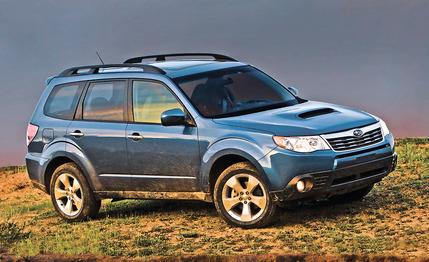 First Drive Review
First Drive Review
Is more always better? The reflexive answer is yes, but remember the old maxim: For every gain, something’s lost.
Consider the 2009 Subaru Forester, third generation in a line dating to 1998. This hard-to-classify five-door (Subaru employs the crossover word, easily the most amoebic term in automotive history) approaches cult status with some owners, but the sales force wants a bigger cult, and market research told them the key to increasing membership was increasing the Forester’s utility index.
This led to a bigger Forester. Structural elements of the new and stiffer body shell are still shared with the compact Impreza, which grew in its 2008 makeover. The 103.0-inch wheelbase is 3.6 inches longer, length has stretched 2.9 inches to 179.5, width increases from 68.3 to 70.1 inches, and the roofline (without the roof rails) is 65.9 inches versus 62.6, although part of this is due to increased ride height—8.9 inches for turbo models versus 8.7 for nonturbos.
In addition to expanding dimensions, the design team reapportioned the interior, creating a rear seat where a couple of adults can perch without polishing their knees on the front seatbacks. Rear cargo volume improves slightly, to 34 cubic feet, although max cargo, with the rear seats folded flat, is about the same at just over 68 cubes.
There’s new sheetmetal, of course—fresh character lines, a new grille, and a tidier hood scoop—but the most important element may be the huge rear window, which improves rear sightlines. This is good news for dogs, cats, and kids who play in driveways.
Other upgrades include a new multilink rear suspension, replacing the previous struts, and a little more suspension travel to go with the increased ride height.
So where’s the “something lost”? One loss is a gain—at the scales. Most new cars today are heavier, thanks to crash regs, and when the new car is also bigger, so is the weight gain. Subaru admits to an increase of about 100 or so pounds. Curb weights range from 3250 pounds for the base 2.5X, with its 2.5-liter flat-four, to 3500 for the top-of-the-line 2.5XT Limited.
Since engine output is essentially unchanged—170 horsepower for the 2.5, 224 for the 2.5 turbo—acceleration is certain to suffer, albeit slightly. More important, the combination of more mass and increased ride height isn’t likely to enhance the Forester’s transient responses. Our early impressions were drawn largely from a half-day with a 2.5X on dirt roads—Subaru believes Forester cultists are more likely than most cute-ute owners to take their rides off-pavement—so we’ll have to wait for a more thorough experience before we draw conclusions. But this latest Forester doesn’t seem to have the rally-car-wannabe feel of its predecessors.
Most lamentable of all, a manual gearbox has vanished from the turbo powertrain.
On the other hand, pricing starts some $1200 down from the 2008 Forester lineup—$20,660 for a base 2.5X, with increased feature content, according to Subaru. That, plus more room, plus improved ride quality, plus standard all-wheel drive, adds up to a pretty attractive value proposition. When it comes to price, less is better.